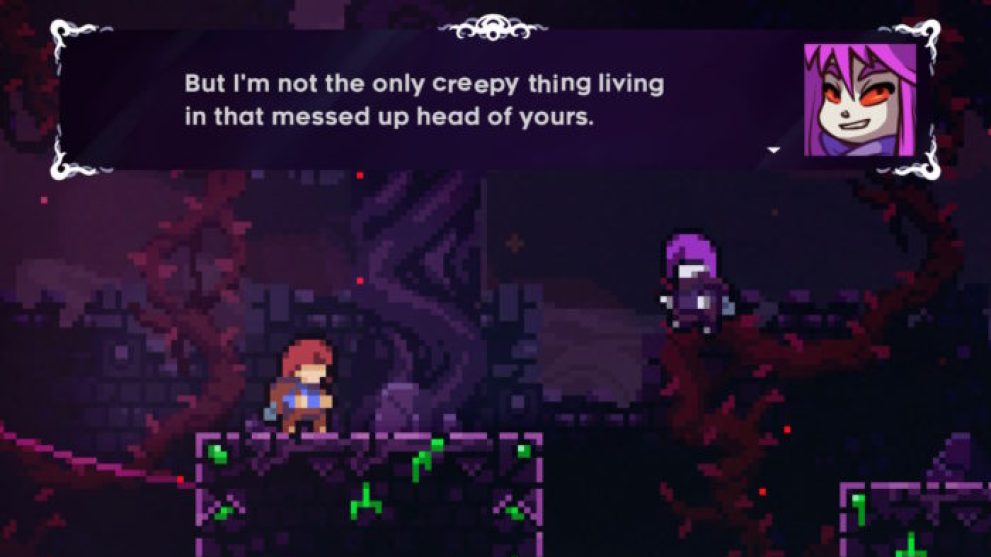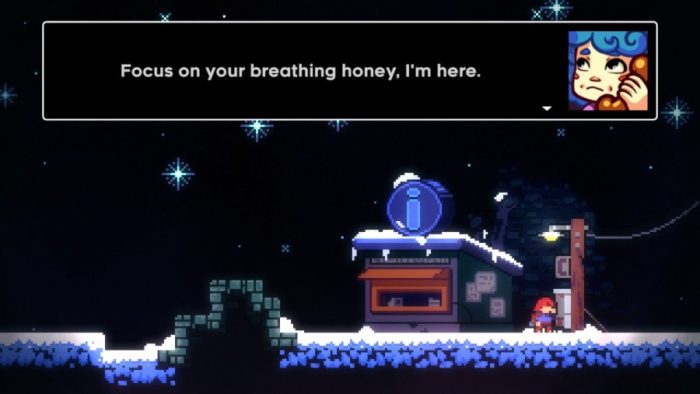Editor’s note: This article contains minor spoilers.
Celeste is a story about the struggle against the seemingly insurmountable. Often, video games celebrate heroes that band together and overcome improbable odds to save the day. These obstacles usually take the form of physical challenges that the protagonist eventually overcomes. Celeste is not that type of story. Celeste is a deeper, more personal tale of struggle. It’s not a story about someone who successfully overcomes all of their conflicts and sails off into the sunset. It’s a story about a woman learning to love herself and coming to terms with the constant struggle that comes with keeping self-depreciation at bay. This is a story that’s all too familiar to anyone who’s ever gotten in their own way.
The game tackles issues like depression, self-loathing, and social anxiety. These aren’t things that can be solved by punching a bad guy or recruiting the right combination of friends. They require self-reflection and the courage to acknowledge and face our inner problems. Celeste manages to intertwine these feelings within both its story and gameplay, creating a heroine that’s easy to resonate with, regardless of their own mental and emotional background.
In Celeste, the player takes control of Madeline, a woman in her twenties who wants to reach Celeste Mountain’s peak. This fictional west Canadian setting is home to supernatural forces. Initially undeterred by the warnings, Madeline forges upwards. The player makes her run, jump, and dash through ever increasingly difficult platforming challenges through a multitude of different settings. Along the way, aspects of Madeline’s suppressed psyche manifests itself in a physical form. Called “Part of Me” or “Part of You” (depending on who is talking), this nemesis haunts her, demanding she abandons her goal and pragmatically voicing how Madeline feels and thinks about the other characters she encounters on her journey.
“Part of Madeline” is terrifying. Through dialogue and cutscenes, the player understands just how much Madeline wants nothing to do with this aspect of her personality. But the player quickly learns to fear Part of Madeline as well. When it shows up, the game’s textures devolve; they glitch and become disjointed. It’s suddenly much more difficult to perceive the correct path towards the goal, and Part of Madeline’s relentless pursuit of Madeline adds a sense of urgency and panic to certain sections of the game that would already be stressful enough to navigate on their own.

Madeline herself suffers from panic attacks. They constrict her breathing and overwhelm her thoughts, and these afflictions cause the self-doubt that fuels Part of Madeline’s taunts. Madeline’s fear of failure paralyzes her. It’s a feeling that becomes all too familiar to the player. Even if the player themselves has never struggled to climb out of mental or emotional pitfalls, Celeste’s gameplay and story weave together a compelling case of how it might feel to be trapped in a never-ending loop of perceived failures.
Part of Madeline helps the player empathize with Madeline’s situation. Her panic attacks make it harder for her to think and react, much like the player’s situation when they have to struggle through a difficult platforming section while also being chased. It’s here, in the parallel between the gameplay and the mental landscape of the main character, that Celeste is at its best, and reminiscent of last year’s Hellblade: Senua’s Sacrifice.
Hellblade helped players empathize with a woman trapped in her own mind from Schizophrenia, a mental illness that had never been really explored in video games before. Here, Celeste’s story and gameplay combine to help the player understand the constant struggle that comes with dealing with panic attacks and depression. Much like Celeste’s levels, both panic attacks and depression are hard to overcome. In fact, they can take on different forms day-to-day, which is represented by the challenge of each different level. Celeste tries to demonstrate that in these extreme moments of difficulty, one feels helplessly and frustratingly paralyzed. It pushes you to the brink, but its entertaining gameplay spurs you on just as you’re ready to throw in the towel.

Celeste, much like dealing with a panic attack or depression, is a constant struggle. The death counter at the end of each level serves to remind the player of their perseverance, but it also weighs heavy on the mind. Madeline’s struggle to overcome her crippling self-doubt and social anxiety throughout the entire game is similarly a choice of her perspective. Her initial reasoning for struggling to overcome the massive task of climbing a mountain is that she believes completing the challenge will “fix” her. It’s only later that she acknowledges the physical hurdles she’s overcoming parallel her own lack of self-confidence. If she’s going to climb this mountain and push back against the depression that gnaws at and constricts her mind, she decides, she’s going to have to change her approach.
All the while, the player is right there with her in her struggle, trying to navigate through a series of platforms, spikes, and bottomless pits. The player understands just how hard it is to climb up to Celeste Mountain’s peak and empathize with how easy it is to blame yourself for self-sabotage when you can’t quite complete something. It’s much harder to try changing how you play the game, but players who learn to adapt and grow will have an easier time on the game’s later levels.

The game makes a point of reminding Madeline – and by extent, the player – that when things get really tough, the best thing to do is stop and breathe. Celeste takes a break from the platforming twice with a minigame that helps slow down Madeline’s breathing. These are, unsurprisingly, before commencing Celeste’s two hardest levels. But the minigame works. It calms Madeline down, and it reminds the player to slow down and center themselves, too.
As the game goes on, Madeline’s resolution to reach the summit transforms into a resolve to always keep striving for even higher peaks. She will keep climbing, both figuratively and literally, towards her goals and a healthy outlook on life. The summit is not the end. It isn’t the goal that will fix her. She’ll be struggling with her depression all her life. But that’s okay. Maybe it’s not the happy ending most gamers were looking for, but it’s empowering all the same, and it’s the one that anyone can identify with and understand.
